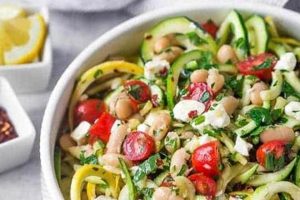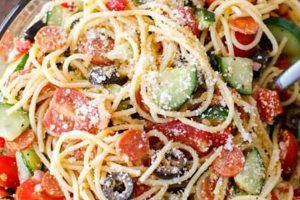A dish featuring cauliflower as the primary ingredient, typically served cold or at room temperature, often incorporating various vegetables, seasonings, and a dressing. A classic example combines raw or blanched cauliflower florets with ingredients like chopped carrots, celery, red onion, and a creamy mayonnaise-based dressing. Variations can include dried fruits, nuts, herbs, and different dressings such as vinaigrettes or yogurt-based sauces.
Cauliflower-based salads offer a nutritious and versatile alternative to traditional lettuce-based salads. They are rich in vitamins, minerals, and fiber, contributing to a healthy diet. The adaptable nature of cauliflower allows for a wide range of flavor profiles and textures, catering to diverse palates. Furthermore, the increased popularity of this dish reflects a growing interest in incorporating more vegetables into meals and exploring creative culinary applications for cauliflower beyond steaming or roasting.
This discussion will further explore variations on this culinary theme, including specific ingredient combinations, preparation techniques, and nutritional information. Tips for selecting and storing cauliflower, as well as suggestions for complementary dishes, will also be provided.
Tips for Cauliflower Salad Preparation
Achieving optimal flavor and texture in a cauliflower salad requires attention to several key aspects of preparation. These tips offer guidance for creating a successful dish.
Tip 1: Cauliflower Selection and Preparation: Select a firm, white cauliflower head free from blemishes. Remove the leaves and core, then cut or break the cauliflower into bite-sized florets. Consider blanching the florets briefly in boiling water to slightly soften the texture while retaining a crisp bite.
Tip 2: Flavorful Dressing Choices: The dressing significantly impacts the overall taste. Classic creamy dressings, tangy vinaigrettes, or lighter yogurt-based options complement cauliflower well. Experiment with different flavors and ingredients to find preferred combinations.
Tip 3: Enhancing Texture and Flavor with Add-ins: Incorporating additional ingredients elevates the salad’s complexity. Chopped vegetables like carrots, celery, bell peppers, and red onion add crunch and color. Dried fruits, nuts, seeds, or fresh herbs contribute both textural and flavor dimensions.
Tip 4: Proper Storage for Optimal Freshness: Store prepared cauliflower salad in an airtight container in the refrigerator. Consume within a few days to maintain optimal quality and prevent spoilage.
Tip 5: Balancing Flavors: Consider the balance of flavors when selecting ingredients. Combine sweet, savory, tangy, and spicy elements to create a well-rounded and appealing taste profile.
Tip 6: Presentation and Serving: A visually appealing presentation enhances the dining experience. Arrange the salad attractively on a platter or in individual bowls. Garnish with fresh herbs or a sprinkle of the chosen add-ins.
Tip 7: Customization and Creativity: Cauliflower salad offers versatility. Feel free to adapt recipes to personal preferences by substituting ingredients, adjusting dressing quantities, or incorporating unique flavor combinations.
By following these tips, one can create a delicious and nutritious cauliflower salad that satisfies a variety of tastes and dietary preferences.
These preparation guidelines provide a foundation for culinary exploration and the creation of flavorful and satisfying dishes.
1. Ingredients
Ingredient selection significantly impacts the flavor, texture, and nutritional value of a cauliflower salad. Careful consideration of components ensures a balanced and satisfying dish. Understanding the role of each ingredient allows for informed choices and creative variations.
- Cruciferous Core: Cauliflower
Cauliflower forms the foundation of the dish. Its preparation influences the final texture. Raw cauliflower offers a crisp bite, while blanched or roasted cauliflower provides a softer texture. The choice depends on the desired outcome and overall flavor profile. Different cauliflower varieties, such as purple or romanesco, introduce unique color and subtle flavor nuances.
- Supporting Vegetables
Beyond cauliflower, other vegetables contribute texture, color, and nutritional value. Common additions include carrots, celery, bell peppers, and red onion. These ingredients offer contrasting textures and flavors, enhancing complexity. For instance, crisp celery complements the softer texture of roasted cauliflower, while vibrant bell peppers add visual appeal.
- Flavor Enhancers: Dressings and Seasonings
Dressings and seasonings are critical for enhancing the overall flavor profile. Vinaigrettes, creamy dressings, or yogurt-based sauces offer distinct taste profiles. Herbs, spices, and other seasonings further contribute to the complexity. A lemon-herb vinaigrette provides a bright, tangy counterpoint to the subtle flavor of cauliflower, while a tahini dressing adds richness and nuttiness.
- Textural Elements: Nuts, Seeds, and Dried Fruits
Optional additions like nuts, seeds, and dried fruits introduce textural variety and additional flavor dimensions. Toasted nuts provide crunch, while dried cranberries or raisins offer a touch of sweetness. These elements contribute complexity and visual appeal, enhancing the overall sensory experience.
The interplay of these ingredient categories defines the character of a cauliflower salad. Balancing the flavors and textures of the core ingredient, supporting vegetables, dressings, and optional add-ins is key to creating a successful and enjoyable dish. By understanding the role and potential of each component, one can confidently explore a wide range of flavor combinations and textures.
2. Preparation Methods
Preparation methods significantly influence the final texture, flavor, and overall appeal of a cauliflower salad. Different techniques offer distinct advantages and contribute to the diversity of this versatile dish. Understanding these methods allows for informed choices and customization based on desired outcomes.
- Raw Incorporation
Utilizing raw cauliflower florets maintains a crisp texture and vibrant flavor. This method preserves the vegetable’s natural nutrients and offers a refreshing element to the salad. It suits preparations emphasizing a light and crunchy texture, often paired with similarly raw vegetables and lighter dressings.
- Blanching
Briefly submerging cauliflower florets in boiling water, then immediately cooling them in ice water, partially cooks the cauliflower, resulting in a slightly softer texture while retaining some crispness. Blanching reduces strong flavors and brightens the cauliflower’s white color, making it ideal for salads with delicate dressings and flavor profiles.
- Roasting
Roasting cauliflower florets in the oven caramelizes their natural sugars, developing a deeper, nuttier flavor and tender texture. This method adds complexity and warmth to the salad, suitable for heartier combinations with roasted vegetables and bolder dressings.
- Pickling
Pickling cauliflower introduces a tangy, acidic dimension. Marinating florets in a vinegar-based brine infuses them with a distinct flavor, adding a unique element to the salad. Pickled cauliflower complements salads with robust flavors and provides a textural contrast to other ingredients.
The chosen preparation method contributes significantly to the overall character of the cauliflower salad. Whether raw, blanched, roasted, or pickled, cauliflower offers a versatile base for a range of flavor profiles and textures. Selecting the appropriate method enhances the dish’s appeal and aligns with the desired culinary outcome.
3. Flavor Profiles
Flavor profiles play a crucial role in defining the character and appeal of a cauliflower salad. The interplay of various ingredients, preparation methods, and dressings contributes to a wide spectrum of potential flavor experiences. Understanding how these elements interact allows for the creation of well-balanced and satisfying dishes. A successful cauliflower salad exhibits a harmonious blend of flavors, creating a cohesive and enjoyable culinary experience.
Consider a classic creamy cauliflower salad. The mild, slightly sweet flavor of cauliflower provides a neutral backdrop for the richness of a mayonnaise-based dressing. Incorporating crisp vegetables like celery and red onion adds contrasting textures and sharpness, while fresh herbs like dill or parsley contribute a bright, herbaceous note. This combination creates a balanced flavor profile, where no single element dominates. In contrast, a roasted cauliflower salad with tahini dressing offers a different experience. The roasting process intensifies the cauliflower’s natural sweetness and imparts a nutty flavor. The earthy, slightly bitter notes of tahini complement the roasted cauliflower, while additions like toasted nuts or dried fruit further enhance the complexity. This illustrates how different ingredient combinations and preparation methods create distinct flavor profiles.
The ability to manipulate and balance flavor profiles provides a powerful tool for culinary creativity. By understanding the inherent flavors of ingredients and how they interact, one can confidently explore a wide range of possibilities. Whether seeking a light and refreshing salad or a more robust and complex dish, careful consideration of flavor profiles is essential. Mastering this aspect of recipe development elevates cauliflower salad from a simple side dish to a versatile and satisfying culinary creation.
4. Nutritional Value
Nutritional value represents a significant factor in the appeal of cauliflower-based salads. Cauliflower itself offers a rich source of vitamins, minerals, and dietary fiber, contributing to overall health and well-being. Specifically, it provides Vitamin C, Vitamin K, folate, and potassium. The inclusion of other vegetables further enhances the nutritional profile. For example, adding carrots contributes Vitamin A and additional fiber, while bell peppers offer Vitamin C and antioxidants. The choice of dressing also influences the nutritional content. A vinaigrette-based dressing, compared to a creamy mayonnaise-based dressing, typically contains fewer calories and less saturated fat. Mindful ingredient selection and preparation methods optimize the nutritional benefits.
Understanding the nutritional composition of a cauliflower salad allows for informed dietary choices. Individuals seeking to increase their vegetable intake or manage specific dietary requirements can tailor recipes to meet their needs. Substituting ingredients, adjusting portion sizes, or modifying dressings enables customization for various dietary goals. For instance, individuals managing sodium intake might opt for a lower-sodium dressing or omit salty add-ins. The nutritional density of cauliflower salads makes them a valuable component of a balanced diet, supporting overall health and well-being. Recipes can be adapted to address individual nutritional needs and preferences, showcasing the versatility and practicality of this dish.
The nutritional value inherent in cauliflower salads provides substantial health benefits. From vitamin and mineral content to fiber and antioxidant properties, these salads offer a nutritious and satisfying meal option. Careful recipe planning, considering ingredient choices and preparation methods, maximizes the nutritional impact. This awareness empowers individuals to make informed decisions about their dietary intake and leverage the health-promoting qualities of cauliflower-based salads.
5. Serving suggestions
Serving suggestions enhance the versatility of cauliflower salad, transforming it from a simple side dish to a central component of various meals. Consideration of complementary flavors and textures elevates the dining experience. Cauliflower salad, with its adaptable nature, pairs well with grilled meats, fish, or poultry. The salad’s refreshing qualities provide a counterpoint to richer, savory dishes. For example, a grilled salmon fillet served alongside a lemon-herb cauliflower salad offers a balanced and flavorful meal. Alternatively, serving cauliflower salad as part of a buffet or potluck allows it to complement a range of dishes, catering to diverse tastes. It can also be incorporated into sandwiches or wraps for a lighter, portable meal option.
The adaptability of cauliflower salad extends to seasonal variations. In warmer months, a lighter, raw cauliflower salad with a vinaigrette dressing provides a refreshing contrast to heavier dishes. During colder months, a roasted cauliflower salad with warm spices offers comforting flavors alongside heartier meals. The salad can be served as a standalone dish for a light lunch or dinner. It can also function as a side dish alongside roasted vegetables, grains, or legumes for a more substantial meal. For larger gatherings, a larger batch of cauliflower salad easily scales to accommodate multiple servings, making it a practical and appealing option.
Effective serving suggestions maximize the enjoyment and practicality of cauliflower salad. Understanding the salad’s flavor profile and textural qualities allows for strategic pairings with other dishes. Considering the occasion and the preferences of those being served further enhances the dining experience. Cauliflower salads adaptability positions it as a versatile culinary component suitable for a variety of occasions and palates. Appropriate serving suggestions highlight its versatility and potential as a standalone dish or a complementary component within a larger meal.
6. Variations
Variations within cauliflower salad recipes demonstrate the dish’s adaptability and potential to cater to diverse tastes and dietary preferences. Exploring these variations unlocks a range of culinary possibilities, expanding beyond basic preparations to encompass a spectrum of flavors, textures, and cultural influences. Examining specific variations highlights the core principles of customization and creativity within the context of cauliflower salad.
- Global Influences
Cultural influences introduce diverse flavor profiles to cauliflower salads. Indian-inspired variations might incorporate curry powder, cumin, and cilantro, while Mediterranean versions could include olives, feta cheese, and oregano. These global adaptations demonstrate the versatility of cauliflower as a base ingredient, readily absorbing flavors from different culinary traditions. A Thai-inspired cauliflower salad, for example, might feature a dressing made with lime juice, fish sauce, and chili flakes, offering a contrasting flavor profile compared to a traditional European-style salad.
- Dietary Adaptations
Dietary restrictions and preferences drive variations catering to specific needs. Vegan versions might utilize a cashew-based dressing instead of traditional mayonnaise, while gluten-free options ensure all ingredients comply with dietary guidelines. These adaptations demonstrate the inclusivity of cauliflower salad, allowing individuals with dietary limitations to enjoy flavorful and satisfying versions of the dish. Paleo-friendly versions might focus on roasted cauliflower, nuts, and seeds, while low-carbohydrate options emphasize non-starchy vegetable additions and minimize higher-carbohydrate ingredients.
- Seasonal Adjustments
Seasonal ingredients introduce variety and freshness. Spring variations might incorporate fresh peas and asparagus, while summer versions could feature grilled corn and tomatoes. Fall variations might utilize roasted root vegetables like sweet potatoes and parsnips, reflecting the season’s bounty. These adjustments demonstrate the adaptability of cauliflower salad to incorporate seasonal produce, enhancing flavor and nutritional value while aligning with the availability of fresh ingredients.
- Textural Explorations
Textural variations expand the sensory experience of cauliflower salad. Incorporating toasted nuts, seeds, or croutons adds crunch, while the addition of dried fruits or roasted chickpeas introduces contrasting textures. These variations demonstrate the potential to create multi-dimensional dishes that engage both palate and tactile senses. A salad featuring roasted cauliflower, crunchy pomegranate seeds, and creamy avocado offers a complex interplay of textures, enhancing the overall enjoyment of the dish.
These variations demonstrate the inherent adaptability of cauliflower salad. By exploring global influences, accommodating dietary restrictions, embracing seasonal ingredients, and experimenting with textural elements, the basic concept of cauliflower salad transforms into a diverse culinary platform. This adaptability makes it a valuable component of any recipe repertoire, offering endless possibilities for customization and creative expression. Whether seeking a light and refreshing salad or a robust and flavorful main course, variations within cauliflower salad recipes ensure a satisfying and enjoyable dining experience tailored to individual preferences and needs.
Frequently Asked Questions
This section addresses common inquiries regarding cauliflower salad preparation, variations, and storage. Clear and concise responses provide practical guidance for achieving optimal results.
Question 1: How can one prevent cauliflower salad from becoming watery?
Excess moisture can be minimized through several techniques. Salting chopped cauliflower and allowing it to drain in a colander reduces water content. Thoroughly drying cauliflower florets after washing or blanching also helps. Additionally, adding dressing shortly before serving prevents the vegetables from releasing excess moisture during storage.
Question 2: What are suitable substitutes for mayonnaise in creamy cauliflower salads?
Greek yogurt, mashed avocado, or a combination of tahini and lemon juice offer healthier alternatives to mayonnaise while maintaining a creamy consistency. These substitutes also introduce distinct flavor profiles, adding complexity to the salad.
Question 3: How long can cauliflower salad be stored in the refrigerator?
Properly stored in an airtight container, cauliflower salad typically lasts for three to five days in the refrigerator. However, salads containing mayonnaise-based dressings may have a shorter shelf life. Always assess the salad’s quality before consumption.
Question 4: Can frozen cauliflower be used for cauliflower salad?
While fresh cauliflower is generally preferred for its texture and flavor, frozen cauliflower can be used in a pinch. Ensure it is thoroughly thawed and drained before incorporating it into the salad to prevent excess moisture.
Question 5: How can one enhance the flavor of a bland cauliflower salad?
Several techniques can elevate the flavor profile. Roasting the cauliflower before adding it to the salad imparts a nutty flavor. Incorporating bolder seasonings, such as roasted garlic, smoked paprika, or curry powder, adds depth and complexity. A squeeze of fresh lemon juice or a splash of vinegar brightens the flavors.
Question 6: Can cauliflower salad be served warm?
While traditionally served cold, cauliflower salad can be served warm, particularly when featuring roasted cauliflower. A warm salad offers a comforting alternative, especially during colder months. Ensure the dressing complements the warm temperature and other ingredients.
Addressing these common questions provides a foundation for successful cauliflower salad preparation and enjoyment. Understanding these practical considerations ensures a satisfying culinary experience.
This concludes the frequently asked questions section. The following section will offer a collection of curated recipes showcasing the versatility of cauliflower salad.
Recipe Cauliflower Salad
This exploration of cauliflower salad recipes has traversed key aspects of preparation, ingredients, flavor profiles, nutritional benefits, serving suggestions, and creative variations. From raw preparations emphasizing freshness and crunch to roasted variations offering nuanced depth, the adaptability of cauliflower as a central ingredient has been clearly demonstrated. The nutritional density of cauliflower, combined with the potential for incorporating diverse ingredients, positions this dish as a valuable component of a balanced and healthful diet. The potential for customization through varied dressings, seasonings, and complementary ingredients further enhances the appeal of cauliflower salad. Understanding the interplay of these elements empowers culinary creativity and ensures a satisfying dining experience.
Cauliflower salad represents more than a simple side dish; it embodies a versatile culinary concept with wide-ranging possibilities. Continued exploration of flavor profiles, textures, and cultural influences promises further innovation within this culinary domain. The inherent adaptability of cauliflower salad ensures its enduring relevance in a constantly evolving culinary landscape. By embracing creativity and informed decision-making regarding ingredient selection and preparation methods, cauliflower salad remains a vibrant and engaging culinary pursuit.






